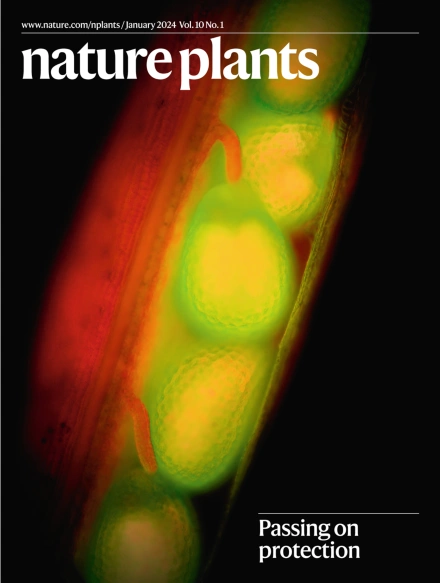MADS31 supports female germline development by repressing the post-fertilization programme in cereal ovules
IF 15.8
1区 生物学
Q1 PLANT SCIENCES
引用次数: 0
Abstract
The female germline of flowering plants develops within a niche of sporophytic (somatic) ovule cells, also referred to as the nucellus. How niche cells maintain their own somatic developmental programme, yet support the development of adjoining germline cells, remains largely unknown. Here we report that MADS31, a conserved MADS-box transcription factor from the B-sister subclass, is a potent regulator of niche cell identity. In barley, MADS31 is preferentially expressed in nucellar cells directly adjoining the germline, and loss-of-function mads31 mutants exhibit deformed and disorganized nucellar cells, leading to impaired germline development and partial female sterility. Remarkably similar phenotypes are observed in mads31 mutants in wheat, suggesting functional conservation within the Triticeae tribe. Molecular assays indicate that MADS31 encodes a potent transcriptional repressor, targeting genes in the ovule that are normally active in the seed. One prominent target of MADS31 is NRPD4b, a seed-expressed component of RNA polymerase IV/V that is involved in epigenetic regulation. NRPD4b is directly repressed by MADS31 in vivo and is derepressed in mads31 ovules, while overexpression of NRPD4b recapitulates the mads31 ovule phenotype. Thus, repression of NRPD4b by MADS31 is required to maintain ovule niche functionality. Our findings reveal a new mechanism by which somatic ovule tissues maintain their identity and support germline development before transitioning to the post-fertilization programme. A somatic niche embraces the female germline in cereal ovules. MADS31 precisely maintains developmental progression of this niche to support the germline by repressing the post-fertilization programme.


MADS31通过抑制谷物胚珠的受精后程序来支持雌性种系发育
开花植物的雌性生殖系在孢子体(体细胞)胚珠细胞的生态位中发育,也称为珠心。生态位细胞如何维持自身的体细胞发育程序,同时又支持相邻生殖系细胞的发育,这在很大程度上仍是未知的。在这里,我们报道了MADS31,一个保守的MADS-box转录因子,来自b姐妹亚类,是一个有效的小生境细胞身份调节剂。在大麦中,MADS31优先表达在直接靠近种系的珠心细胞中,功能丧失的MADS31突变体表现出畸形和无组织的珠心细胞,导致种系发育受损和部分雌性不育。在小麦的mads31突变体中观察到非常相似的表型,表明小麦族的功能守恒。分子分析表明,MADS31编码一种有效的转录抑制因子,靶向通常在种子中活跃的胚珠基因。MADS31的一个重要靶点是NRPD4b,它是RNA聚合酶IV/V的一种种子表达成分,参与表观遗传调控。NRPD4b在体内被MADS31直接抑制,在MADS31胚珠中被抑制,而NRPD4b的过表达再现了MADS31胚珠表型。因此,维持胚珠生态位功能需要MADS31抑制NRPD4b。我们的发现揭示了体细胞胚珠组织在过渡到受精后程序之前维持其身份并支持种系发育的新机制。
本文章由计算机程序翻译,如有差异,请以英文原文为准。
求助全文
约1分钟内获得全文
求助全文
来源期刊

Nature Plants
PLANT SCIENCES-
CiteScore
25.30
自引率
2.20%
发文量
196
期刊介绍:
Nature Plants is an online-only, monthly journal publishing the best research on plants — from their evolution, development, metabolism and environmental interactions to their societal significance.
 求助内容:
求助内容: 应助结果提醒方式:
应助结果提醒方式:


